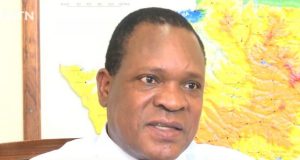THE Financial Gazette and the Zimbabwe Agricultural Society, in partnership with CBZ Bank will publish the findings of the 4th edition of the Zimbabwe Agricultural Sector Survey on November 23, 2022. In preparation for the launch, The Financial Gazette’s Senior Staff Writer, Farai Mabeza (FM) spoke to Agriculture minister, Anxious Masuka (AM), who will be the guest of honour at the event. Below are excerpts of the interview.

FM: Your tenure under the second Republic has coincided with agricultural transformation in Zimbabwe. May you give us an insight into this unfolding agricultural transformation agenda, including Rural Development 8.0 and what it means to Zimbabwe?

Agriculture minister Anxious Masuka
AM: If it’s coincidence that my arrival at the Ministry resulted in transformation of the sector, then serendipity favours the prepared man. The President, His Excellency Dr ED Mnangagwa, launched the bold, radical and transformative “Agriculture and Food Systems Transformation Strategy” in August 2020, to mark the much-needed shift in our agricultural ethos, philosophy and strategy. The core outcomes include achieving food security, eliminating Imports through substitution, and diversifying as well as deepening exports.
Rural Development 8.0 comprises a series of outcome-based interventions impacting the attainment of Vision 2030. It is based on the indisputable fact that our economy is agro-based, so it is agriculture that must power communities out of poverty, principally the 9,2 million (61 percent of the population) in rural areas who daily derive their livelihoods from farming. Rural Development 8.0 is also based on the scientific observation of the strong “Agricultural Development-Rural Industrialisation-Rural Development-Vision 2030 nexus”. This is further buttressed by observations that development originating from the agricultural sector is twice as powerful at lifting people out of poverty as development emanating from any other sector. Furthermore, no country has transitioned from a low-income economy to a middle or upper-middle-income economy without increasing agricultural productivity. We are thus persuaded to conclude that Agricultural Development will cause Rural Industrialisation. Rural Industrialisation will cause Rural Development. Rural Development will ACCELERATE AND FACILITATE the Attainment of Vision 2030.
It is in this regard that the elements of Rural Development 8.0 have been carefully selected to impact three action tracks of crops, horticulture, and livestock at household level, so we can transform household by household, and village by village.

FM: We understand that your ministry is working hard to reduce the spread of livestock diseases in Zimbabwe. What measures is the government taking and what are the results?
AM: Livestock provides income, status and employment to farmers, as 90 percent of the 5,6 million livestock is in communal areas. Over the years some 50 percent of the 4000 dip tanks became derelict, so disease such as January Disease and Foot and Mouth Disease became a menace. Since 2019 we have resolved to change the situation through the Livestock Growth Strategy, focusing on eliminating diseases, improving genetics and improving pastures. Consequently, some 67 percent of dip tanks are now operational, as we aim to rehabilitate over 500 dip tanks annually. In the interim, since 2020, we have given the one million cattle-owning households one kg of tick grease each to control tick-borne disease. Resultantly, a 47 percent reduction in tick-borne deaths was recorded in 2020, and a further reduction of 39 percent was recorded in 2021. In 2021 we recorded a small increase of 0,6 percent in livestock numbers. This augurs well for future growth.
On the FMD front, we now have sufficient stocks of vaccine, and detection and surveillance of the disease have improved, following massive capacitation of both the technical and extension systems. Quarantine activities are in place, and farmers are urged to play their part by restricting cattle movements as directed. Sadly, we have had to destroy some cattle from delinquent cattle movements. The barrier fences with national parks are also now been being put up to reduce buffalo-animal contact and reduce FMD further.
FM: On the repositioning and realignment of key agriculture institutions, may you update us on the thinking behind the realignment?
 AM: There is change happening at scale and pace as we position the sector for this inevitable rapid growth. The Ministry itself has changed names twice in two years! We have over 25 000 staff in the Ministry and its parastatals (13 000 and 12 000, respectively, of those in post). In the Ministry, we have created new departments, such as the Agricultural and Rural Development Advisory Services. We have brought in change management training and re-orientation of staff. We have introduced innovative cost-cutting extension methods. We have changed our agricultural colleges’ delivery system from Agricultural Extension 2.0 to Agricultural Education for Development 5.0. We have formed stakeholder groups to provide platforms for the exchange of ideas with the private sector and farmers. But we can do much more. At our parastatals, we classed them in 2020 into a “Reform, Restructure, Transform Matrix”. We gave all of them new mandates which Boards signed to align them with Vision 2030 and the new Strategy. Many of them have had to rebrand. You have seen the new ARDA, the new AMA, the new ZINWA, the new COTTCO, the new TIMB, the new GMB. Exciting times indeed.
AM: There is change happening at scale and pace as we position the sector for this inevitable rapid growth. The Ministry itself has changed names twice in two years! We have over 25 000 staff in the Ministry and its parastatals (13 000 and 12 000, respectively, of those in post). In the Ministry, we have created new departments, such as the Agricultural and Rural Development Advisory Services. We have brought in change management training and re-orientation of staff. We have introduced innovative cost-cutting extension methods. We have changed our agricultural colleges’ delivery system from Agricultural Extension 2.0 to Agricultural Education for Development 5.0. We have formed stakeholder groups to provide platforms for the exchange of ideas with the private sector and farmers. But we can do much more. At our parastatals, we classed them in 2020 into a “Reform, Restructure, Transform Matrix”. We gave all of them new mandates which Boards signed to align them with Vision 2030 and the new Strategy. Many of them have had to rebrand. You have seen the new ARDA, the new AMA, the new ZINWA, the new COTTCO, the new TIMB, the new GMB. Exciting times indeed.
FM: What are the prospects of the winter wheat crop and what is the formula behind the expected harvest?
AM: In 2019 we had 34 000 hectares under wheat, in 2020 we had 45 000 hectares, in 2021 we had 67 000 hectares and in 2022 we have 79 000 hectares under wheat. On the back of conflict in wheat source markets in Europe, disruption of supply chains due to the Covid-19 pandemic, and climate change the government made a deliberate decision to become wheat self-sufficient in the 2022 season. We require 360 000 metric tonnes of soft wheat annually which we must produce ourselves. Our expected harvest is 386 000 metric tonnes, so we can begin to build a small strategic reserve, making Zimbabwe and Ethiopia the only two nations in Africa with sufficient local production of wheat. Both the import substitution thrust through our Agriculture Recovery Plan and the Accelerated Irrigation Rehabilitation and Development Plan contributed to this stellar success. Government, the private sector and self-financed farmers worked together to bring about this exciting wheat success story. We must carry this momentum into summer and produce a record maize crop, a record traditional grains crops, a record tobacco crop, and a record cotton crop. This is possible.
FM: Where are we in terms of preparations for the summer cropping season and how is the rain forecast looking?
AM: Cabinet approved the country’s summer 2022/23 crop and livestock programme in April 2022. This was done early because of the ongoing geopolitical conflict in Eastern Europe. This conflict has impacts on global supply chains and inputs for agriculture such as fertiliser and fuel. The 2022/23 summer programme’s focuses on achieving “food, feed and fibre security for the nation”
FM: What should farmers do to complement government efforts to mitigate the impact of climate change on agriculture?
AM: The mind shift to agriculture as a business is critical for sustained transformation of the sector. We want to transform the 3 million rural households from subsistence farming to surplus-oriented farming, so that they too, can become economic participants, not economic spectators. We want to transform the 360 00 A1 farmers from surplus-oriented farmers to annually successful commercial farmers. We want to transform the 23 000 A2 farmers from commercial farmers to perennially successful businesswomen and businessmen, in the business of agriculture. This is our challenge and an obligation to be achieved together, as government, farmers and all value chain actors.
FM: On 23 November, findings of the 2021/2 agricultural sector survey would be shared with the public at a breakfast ceremony. As the guest of honour at this important annual event, what are your expectations from the Zimbabwe Agricultural Sector Survey?
AM: Since the launch of the survey, government has looked at the findings as providing much-needed additional information for planning purposes. I hope this will continue to be the case, so objectivity is key. I also hope that the survey can highlight the many areas we are doing well, while not shying away from equally highlighting areas where we have not done so well, and areas we have neglected.
FM: What is the significance of this year’s survey theme (Agricultural Transformation: Adaptation, Productivity, Value Chains) to the realisation of vision 2030?
AM: The Ministry uses a value chain approach to enhance transformation and development for the identified 25 crops and horticulture value chains, and nine livestock value chains. The theme, therefore, rhymes with government’s current agricultural thrust, so I hope the findings will really complement our current efforts at transforming this important sector.



